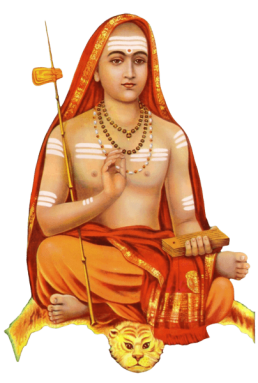स्वाज्ञानकॢप्तैरखिलैरुपाधिभिः ।
विमुक्तमात्मानमखण्डरूपं
पूर्णं महाकाशमिवावलोकयेत् ॥ ३८४ ॥
svājñānakḷptairakhilairupādhibhiḥ |
vimuktamātmānamakhaṇḍarūpaṃ
pūrṇaṃ mahākāśamivāvalokayet || 384 ||
गगनमुपाधिशतैर्विमुक्तमेकम् ।
भवति न विविधं तथैव शुद्धं
परमहमादिविमुक्तमेकमेव ॥ ३८५ ॥
gaganamupādhiśatairvimuktamekam |
bhavati na vividhaṃ tathaiva śuddhaṃ
paramahamādivimuktamekameva || 385 ||
ततः पूर्णं स्वमात्मानं पश्येदेकात्मना स्थितम् ॥ ३८६ ॥
tataḥ pūrṇaṃ svamātmānaṃ paśyedekātmanā sthitam || 386 ||
तत्तन्मात्रं नैव तस्माद्विभिन्नम् ।
भ्रान्तेर्नाशे भाति दृष्टाहितत्त्वं
रज्जुस्तद्वद्विश्वमात्मस्वरूपम् ॥ ३८७ ॥
tattanmātraṃ naiva tasmādvibhinnam |
bhrānternāśe bhāti dṛṣṭāhitattvaṃ
rajjustadvadviśvamātmasvarūpam || 387 ||
स्वयं विश्वमिदं सर्वं स्वस्मादन्यन्न किंचन ॥ ३८८ ॥
svayaṃ viśvamidaṃ sarvaṃ svasmādanyanna kiṃcana || 388 ||
स्वयं पुरस्तात्स्वयमेव पश्चात् ।
स्वयं ह्यावाच्यां स्वयमप्युदीच्यां
तथोपरिष्टात्स्वयमप्यधस्तात् ॥ ३८९ ॥
svayaṃ purastātsvayameva paścāt |
svayaṃ hyāvācyāṃ svayamapyudīcyāṃ
tathopariṣṭātsvayamapyadhastāt || 389 ||
सर्वं स्वरूपेण जलं यथा तथा ।
चिदेव देहाद्यहमन्तमेतत्
सर्वं चिदेवैकरसं विशुद्धम् ॥ ३९0 ॥
sarvaṃ svarūpeṇa jalaṃ yathā tathā |
cideva dehādyahamantametat
sarvaṃ cidevaikarasaṃ viśuddham || 390 ||
सतोऽन्यन्नास्त्येव प्रकृतिपरसीम्नि स्थितवतः ।
पृथक्किं मृत्स्नायाः कलशघटकुम्भाद्यवगतं
वदत्येष भ्रान्तस्त्वमहमिति मायामदिरया ॥ ३९१ ॥
sato’nyannāstyeva prakṛtiparasīmni sthitavataḥ |
pṛthakkiṃ mṛtsnāyāḥ kalaśaghaṭakumbhādyavagataṃ
vadatyeṣa bhrāntastvamahamiti māyāmadirayā || 391 ||
ब्रवीति द्वैतराहित्यं मिथ्याध्यासनिवृत्तये ॥ ३९२ ॥
bravīti dvaitarāhityaṃ mithyādhyāsanivṛttaye || 392 ||
False superimpositions—i. e. considering the Knower, Knowledge and Known as distinct entities.
निःसीमनिःस्पन्दननिर्विकारम् ।
अन्तर्बहिःशून्यमनन्यमद्वयं
स्वयं परं ब्रह्म किमस्ति बोध्यम् ॥ ३९३ ॥
niḥsīmaniḥspandananirvikāram |
antarbahiḥśūnyamananyamadvayaṃ
svayaṃ paraṃ brahma kimasti bodhyam || 393 ||
ब्रह्मैतज्जगदाततं नु सकलं ब्रह्माद्वितीयं श्रुतिः ।
ब्रह्मैवाहमिति प्रबुद्धमतयः संत्यक्तबाह्याः स्फुटं
ब्रह्मीभूय वसन्ति सन्ततचिदानन्दात्मनैतद्ध्रुवम् ॥ ३९४ ॥
brahmaitajjagadātataṃ nu sakalaṃ brahmādvitīyaṃ śrutiḥ |
brahmaivāhamiti prabuddhamatayaḥ saṃtyaktabāhyāḥ sphuṭaṃ
brahmībhūya vasanti santatacidānandātmanaitaddhruvam || 394 ||
प्रसभमनिलकल्पे लिङ्गदेहेऽपि पश्चात् ।
निगमगदितकीर्तिं नित्यमानन्दमूर्तिं
स्वयमिति परिचीय ब्रह्मरूपेण तिष्ठ ॥ ३९५ ॥
prasabhamanilakalpe liṅgadehe’pi paścāt |
nigamagaditakīrtiṃ nityamānandamūrtiṃ
svayamiti paricīya brahmarūpeṇa tiṣṭha || 395 ||
परेभ्यः स्यात्क्लेशो जननमरणव्याधिनिलयः ।
यदात्मानं शुद्धं कलयति शिवाकारमचलम्
तदा तेभ्यो मुक्तो भवति हि तदाह श्रुतिरपि ॥ ३९६ ॥
parebhyaḥ syātkleśo jananamaraṇavyādhinilayaḥ |
yadātmānaṃ śuddhaṃ kalayati śivākāramacalam
tadā tebhyo mukto bhavati hi tadāha śrutirapi || 396 ||
Brihadaranyaka I. iv. 2—“So long as there is a second, there is fear.”
Srutis also .—e. g. Chhandogya VIII. xii. 1—“This body is mortal, O Indra,” .
स्वयमेव परं ब्रह्म पूर्णमद्वयमक्रियम् ॥ ३९७ ॥
svayameva paraṃ brahma pūrṇamadvayamakriyam || 397 ||
As Itself—in Its own essence.
Vivekachudamani – Introduction
1: Devoted Dedication
2: Glory of Spiritual Life
3: Unique Graces in Life
4-7: Miseries of The Unspiritual Man
8-13: Means of Wisdom
14-17: The Fit Student
18-30: The Four Qualifications
31: Bhakti – Firm and Deep
32-40: Courtesy of Approach and Questioning
41-47: Loving Advice of the Guru
48-49: Questions of the Disciple
50: Intelligent Disciple – Appreciated
51-55: Glory of Self-Effort
56-61: Knowledge of the Self-Its Beauty
62-66: Direct Experience – Liberation
67-71: Discussion on Questions Raised
72-75: Gross Body
76-82: Sense Objects a Trap – Man Bound
83-86: Fascination for Body Criticised
87-91: Gross Body Condemned
92: Organs of Perception and Action
93-94: Inner Instruments
95: The Five Pranas
96-101: Subtle Body – Effects
102: Functions of Prāna
103-105: Ego Discussed
106-107: Infinite Love – the Self
108-110: Māyā – Pointed Out
111-112: Rajoguņa – Nature and Effects
113-116: Tamoguņa – Nature and Effects
117-119: Sattvaguņa – Nature and Effects
120-121: The Causal Body – Its Nature
122-123: Not-Self – Description
124-135: The Self – Its Nature
136: Advice for Self-control
137-142: What is Bondage – The Reply
143-144: The Powers – Agitation and Veiling
145-146: Bondage in Action
147-153: Ātman and Anātman – Discrimination
Negation of the Kośas
154-164: – Annamaya kośa (Food sheath)
165-166: – Prņamaya kośa (Vital air sheath)
167-183: – Manomaya kosa (Mental sheath)
184-188: – Vijnanamaya kośa (Intellectual sheath)
189-191: Ātman – Unattached
192-193: What is Liberation? – Disciple
194-206: Self-Knowledge gives Liberation
207-210: Anandamaya kośa (Bliss sheath)
211: Ātman – Other than the Five Kośas
212: What is Ātman? – Disciple
213-225: Nature of the Self – Discussion
226-236: All Manifestation Absolute
237-240: Brahman – Its Nature
241-249: That Thou Art – Explanation
250-253: Attitude in Meditation
254-266: Aids to Meditation
267-276: Give up Vāsanās – the Method
277-292: End Superimposition – The Means
293-297: The Perceived I’ Factor – False
298-309: Condemnation of the Ego
310-319: Actions, Thoughts and Vāsanās – Renounce
320-329: Total Vigilance – Its Price
330-338: In the One, No Plurality
339-348: Spiritual Growth – the Secret
349-353: Cause-Effect – False
354-372: Samadhi – Its Nature
373-378: Fully Detached – Samadhi Easy
379-383: Meditation – the Technique
384-397: Continuous Attention to Self
398-406: No Diversity in Reality
407-413: Ātma-vicāra – Contemplation
414-418: Give up Perceptions
419-425: The Science of Reality – Its Benefits
426-445: Signs of a Realised Seer
446-464: Prārabdha for a Saint
465-471: There is No Plurality
472-479: Experience of Selfhood
480-520: Practice of Knowledge – Disciple
521-575: Final Words of Advice
576-578: Blessed Disciple Liberated
579-581: The Glory of the Textbook

Vivekachudamani – Verses 384-397 – Vivekachudamani Verses 384-397 – By Adi Sankaracharya – In Sanskrit with English Meaning, Transliteration, Translation, Commenary, Lyrics, Audio – Vivekachudamani-384-397
